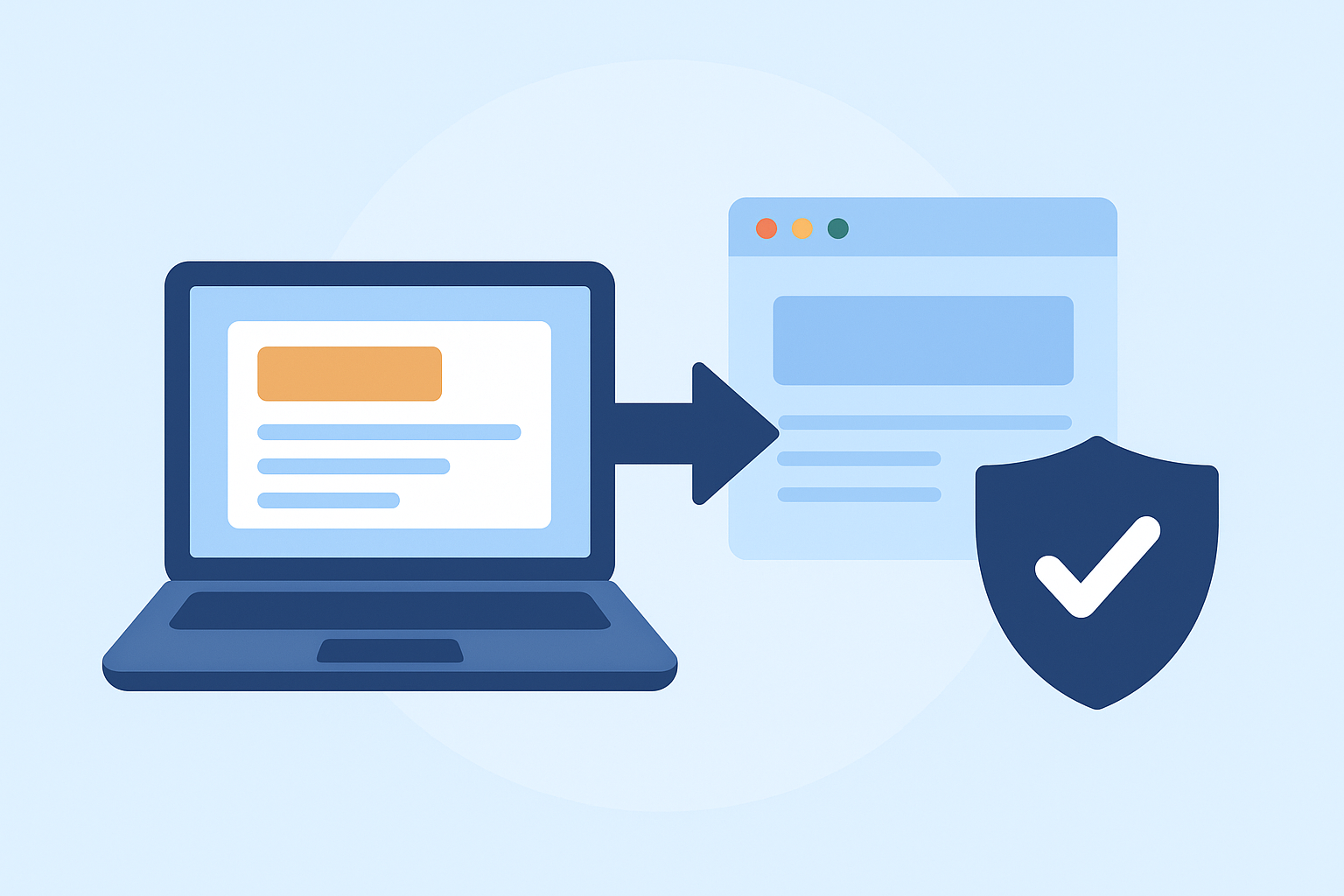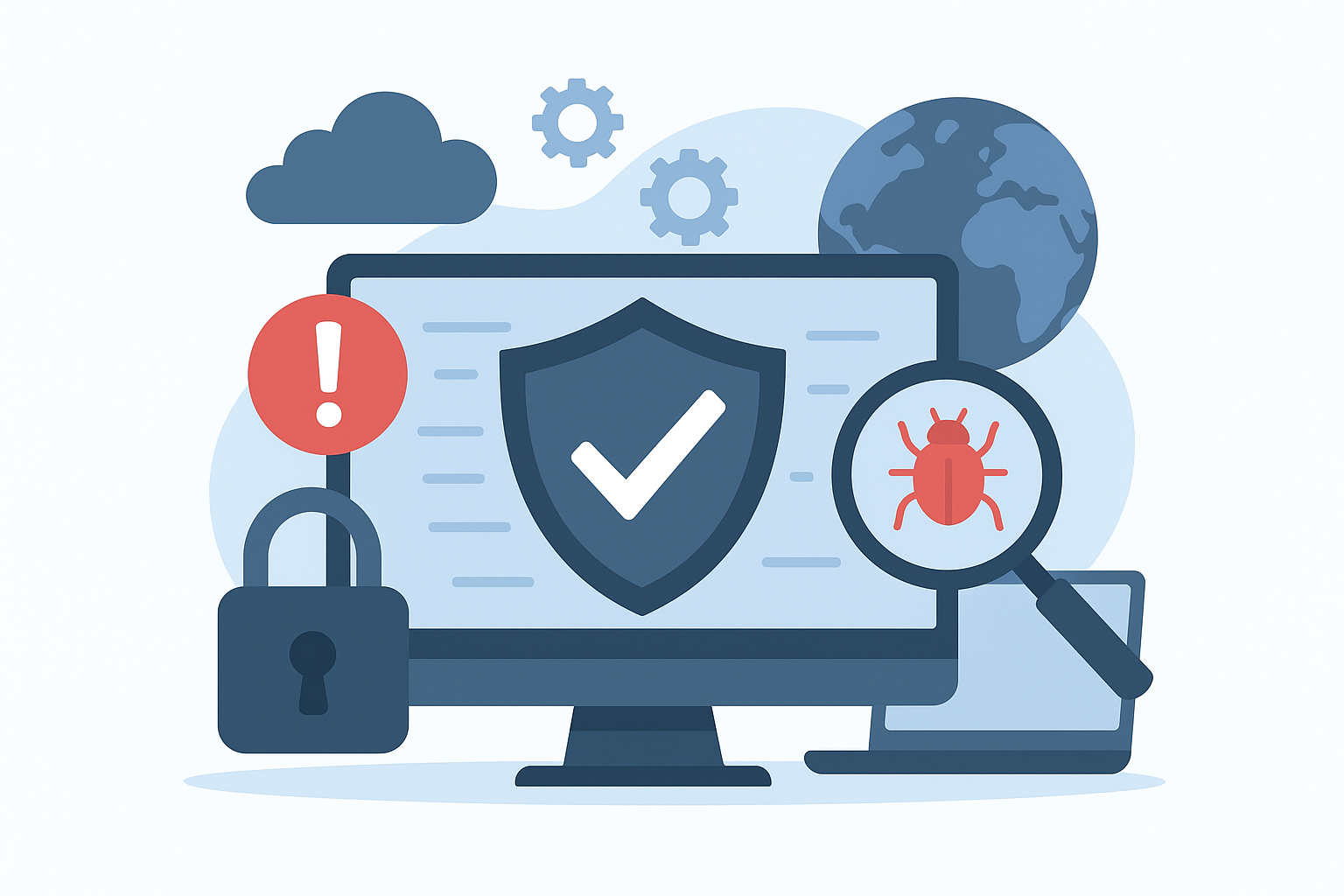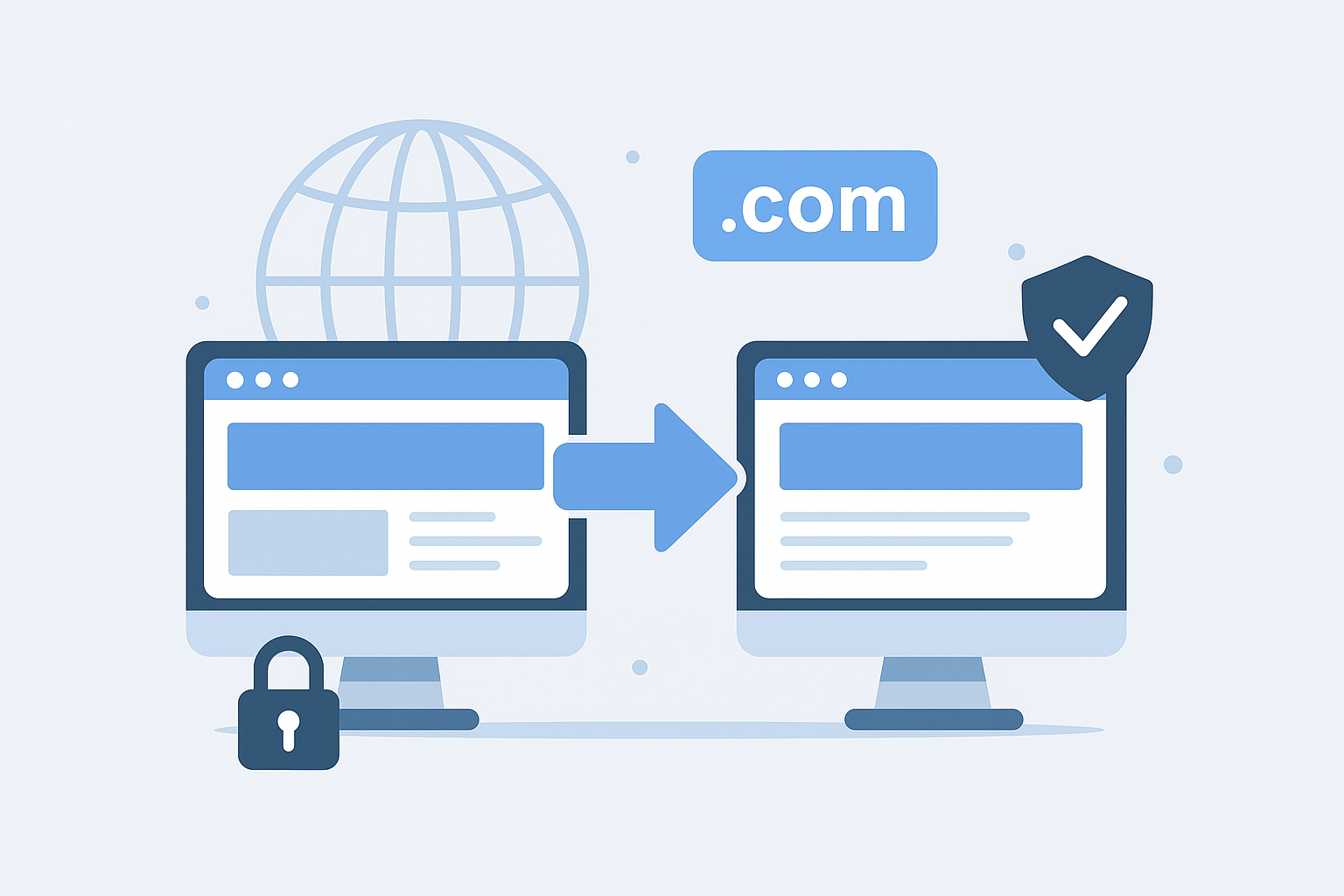Migrating a website and domain is one of the most important yet delicate processes any business can undertake. Whether it is done to improve performance, strengthen security, or rebrand an online presence, the process of Website and Domain Migration requires careful planning and execution. Done correctly, it can elevate a business’s digital footprint, but without the right approach, it can lead to downtime, SEO loss, and broken functionalities. This detailed guide will walk you through every aspect of migration, from preparation to execution, ensuring your online presence remains stable and continues to grow.
Introduction to Website and Domain Migration
When a business decides to shift its online presence, the process is not as simple as moving files from one folder to another. Website and Domain Migration involves transferring all critical elements of a website, including content, databases, email servers, and DNS configurations, while ensuring that the online visibility and brand identity are preserved. This process has become increasingly vital as companies evolve their infrastructure, update to faster servers, or shift to stronger, more recognizable domain names. At FixHackedSite, we often encounter business owners who underestimate the complexity of migration until they face broken pages, security gaps, or SEO drops.
The core challenge with migration lies in striking a balance between technical accuracy and digital continuity. A poorly executed migration can cause extended downtime, which not only frustrates users but also damages a company’s credibility. Moreover, search engines may temporarily or permanently reduce rankings if redirects, URL structures, and sitemaps are not carefully handled. On the other hand, when the migration is executed strategically, businesses often find that it results in faster website performance, enhanced brand recognition, and improved scalability.
Thus, the importance of Website and Domain Migration cannot be overstated. Businesses must treat it as a long-term investment in their digital infrastructure rather than a mere technical task. By having a detailed roadmap and professional oversight, organizations can transition smoothly to a stronger, more efficient, and more secure web environment. This ensures that both customers and search engines continue to trust and engage with the website without interruptions or concerns.
Understanding the Core Concept of Website and Domain Migration
To truly appreciate the process of Website and Domain Migration, one must first understand its core definition. Migration is essentially the transfer of a digital property, where not only files but also hosting environments, databases, and configurations are carefully transitioned. Unlike a basic copy-paste method, migration demands precision because the goal is to recreate the same digital identity on a new platform or domain without disrupting user experience. Every element, from the URL structure to the SSL certificates, plays a role in ensuring that the transition appears seamless to visitors. This makes migration both a technical and strategic undertaking.
When businesses undergo migration, the reasons are often tied to growth, branding, or security. Some may need better hosting servers to handle increased traffic, while others may be shifting their branding strategy to adopt a more professional domain name. The process can also stem from the need to integrate advanced technologies or content management systems that were not previously supported. No matter the reason, the goal is always the same: to improve performance, reliability, and visibility. By carefully planning and executing migration, companies can ensure that they preserve their search engine rankings, protect sensitive data, and maintain brand reputation.
Another aspect to consider in Website and Domain Migration is the impact on end-users. For visitors, the experience should remain smooth, fast, and uninterrupted. A well-managed migration guarantees that customers do not face broken links, confusing redirects, or downtime. This is where businesses must invest in professional expertise, because even minor mistakes can lead to long-term setbacks. With the right strategy, however, migration becomes a stepping stone toward a more powerful and secure digital presence that aligns with the company’s vision for future growth.
Why Businesses Need Website and Domain Migration
The decision to undergo Website and Domain Migration is rarely impulsive. It often arises from critical business needs that directly influence digital performance and brand identity. Companies evolve, and with that evolution comes the requirement for improved online infrastructure. Whether it is about moving away from outdated hosting providers, adopting faster servers, or rebranding with a new domain name, migration enables businesses to align their online presence with their long-term objectives. It serves as a gateway for embracing new opportunities while resolving existing limitations.
One of the most common reasons is scalability. As businesses grow, their websites attract more visitors and handle larger volumes of data. If the existing infrastructure cannot manage this growth, the site becomes sluggish, which frustrates users and reduces conversion rates. Migration to a better hosting environment allows businesses to keep pace with traffic demands, ensuring that the website remains responsive under heavy loads. Additionally, when a company chooses a stronger, more relevant domain name, it instantly increases credibility in the eyes of both customers and search engines, making migration a direct investment in brand recognition.
Security also plays a vital role in the decision-making process. Older hosting platforms or poorly managed domains may expose businesses to vulnerabilities such as malware, hacking attempts, and data breaches. By migrating to a modern, secure environment, organizations can fortify their defenses against cyber threats. Furthermore, implementing Website and Domain Migration allows businesses to adopt the latest protocols, SSL certifications, and data encryption methods, ensuring a trustworthy experience for users. The ultimate goal is not just to move but to improve, creating a safer, faster, and more reliable digital home for both businesses and their audiences.
Common Challenges in Website and Domain Migration
While Website and Domain Migration offers immense benefits, it is also riddled with challenges that businesses must prepare for. One of the most common hurdles is downtime. If the migration is not carefully timed or executed, the website may go offline for extended periods, leading to lost revenue, decreased user trust, and lower search engine rankings. Even a few hours of downtime can significantly impact businesses that rely on e-commerce or global customer interactions. Hence, downtime management becomes one of the biggest concerns during migration.
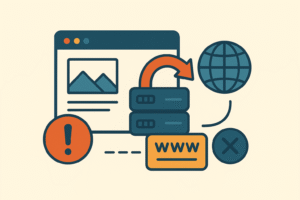 Another major challenge is data integrity. During the transfer of files, databases, and settings, there is always a risk of data loss or corruption. Broken links, missing images, or incomplete forms can disrupt user experience and cause frustration. Search engine optimization (SEO) is another area at risk, as changes in URL structures, redirects, or metadata can result in ranking drops. Businesses often underestimate the importance of mapping old URLs to new ones and ensuring that redirects are implemented correctly. Without this, search engines may treat the migrated site as an entirely new entity, leading to traffic declines.
Another major challenge is data integrity. During the transfer of files, databases, and settings, there is always a risk of data loss or corruption. Broken links, missing images, or incomplete forms can disrupt user experience and cause frustration. Search engine optimization (SEO) is another area at risk, as changes in URL structures, redirects, or metadata can result in ranking drops. Businesses often underestimate the importance of mapping old URLs to new ones and ensuring that redirects are implemented correctly. Without this, search engines may treat the migrated site as an entirely new entity, leading to traffic declines.
Technical complexities further compound these challenges. From DNS propagation delays to SSL certificate misconfigurations, even minor oversights can create significant problems. Organizations must also account for compatibility issues when moving between different hosting platforms or content management systems. The good news is that with thorough planning, expert assistance, and meticulous execution, these challenges can be effectively minimized. The key is to anticipate potential issues, create contingency plans, and test the migrated environment thoroughly before making it live to the public.
The Importance of Planning Before Migration
Planning is the backbone of a successful Website and Domain Migration. Without a clear roadmap, businesses risk falling into common pitfalls such as extended downtime, broken functionalities, or SEO penalties. Proper planning involves assessing the current website, documenting its structure, and identifying potential risks. This step ensures that every element, from content to technical configurations, is accounted for before the transition begins. Migration is not just a technical move; it is a business-critical decision that impacts visibility, trust, and growth.
One of the most important aspects of planning is setting clear objectives. Businesses must determine whether the migration is driven by performance upgrades, security enhancements, branding improvements, or a combination of these factors. Once objectives are defined, the technical requirements become clearer, such as the need for faster hosting, scalable architecture, or SEO-preserving redirects. Creating a timeline also plays a vital role, as migration should ideally be scheduled during periods of low traffic to minimize disruptions. This timeline must include checkpoints for testing, troubleshooting, and verification.
Another critical component of planning is communication. Stakeholders, including development teams, content creators, and marketing managers, must be aligned with the process. Customers should also be informed in advance if downtime is expected. Additionally, businesses should prepare backups of all data, ensuring that nothing is permanently lost during the transition. By focusing on comprehensive planning, companies increase their chances of achieving a smooth migration that enhances performance while safeguarding brand credibility. Ultimately, preparation determines whether a migration is a risky gamble or a strategic success.
Technical Aspects of Website Migration
The technical side of Website and Domain Migration is the foundation upon which a successful transition is built. At its core, the process involves transferring website files, databases, email servers, and DNS records to a new environment. Every single element needs to be precisely configured to ensure that the new setup mirrors the old one in both functionality and performance. Technical accuracy ensures that the website remains consistent, preventing users from encountering broken pages or experiencing downtime. This phase is often complex, as it requires not only knowledge of server configurations but also an understanding of how search engines index and interpret websites.
One critical technical step is DNS configuration. When migrating to a new domain or hosting provider, businesses must update DNS records to point traffic from the old server to the new one. This change takes time to propagate globally, which is why it is important to plan for potential delays. Similarly, ensuring SSL certificates are installed correctly is essential, as it preserves secure HTTPS connections for users. A single misstep in SSL setup can cause browsers to display security warnings, which can discourage visitors from engaging with the site. File permissions, database connections, and caching mechanisms must also be carefully reviewed and tested to maintain stability.
Beyond the basics, businesses must also focus on advanced optimizations during migration. This includes compressing images, minifying scripts, and configuring content delivery networks (CDNs) to improve site speed. These improvements not only enhance user experience but also contribute to higher search engine rankings. Proper server-side configurations, such as PHP versions, database performance tuning, and firewall settings, must also be aligned with the new environment. By prioritizing these technical aspects, companies ensure that the migrated website not only works seamlessly but also performs better than before.
SEO Considerations During Migration
Search engine optimization is perhaps the most vulnerable area during Website and Domain Migration. When handled poorly, migration can cause a significant drop in rankings, leading to a loss of organic traffic and revenue. This happens because search engines rely on consistent signals such as URL structures, metadata, and sitemaps to understand a site’s content. When these signals change abruptly without proper redirects or updates, search engines may treat the new site as an entirely different entity, erasing years of SEO efforts.
One of the most important steps to protect SEO is setting up 301 redirects from old URLs to their corresponding new ones. This ensures that both users and search engines are seamlessly guided to the updated pages without losing authority. In addition, updating internal links, meta descriptions, and canonical tags is essential to maintain consistency. Businesses must also resubmit updated XML sitemaps and robots.txt files to search engines to help them crawl and index the new environment effectively. Without these measures, pages may be left unindexed, resulting in traffic loss.
Moreover, monitoring SEO performance after migration is just as crucial as preparation. Tools like Google Search Console and analytics platforms allow businesses to track crawling errors, ranking fluctuations, and traffic shifts. It is common to see minor dips in visibility immediately after migration, but with proper management, rankings should recover and eventually improve. The key is to remain proactive—fixing errors promptly and ensuring that search engines clearly understand the continuity between the old and new setups. By treating SEO as an integral part of migration rather than an afterthought, businesses protect their digital investments while laying the foundation for long-term growth.
The Role of Backups in Migration
Backups are the safety net of any Website and Domain Migration process. Before making any changes, businesses must ensure that complete copies of their websites, databases, and email servers are securely stored. This precaution guarantees that if anything goes wrong during migration—whether due to technical errors, misconfigurations, or unexpected failures—the original site can be restored without data loss. Without proper backups, a simple mistake can escalate into catastrophic downtime or the permanent loss of valuable content.
Creating backups is not just about duplicating files; it involves capturing every detail of the website’s current environment. This includes databases containing user information, content management system configurations, and plugin or extension settings. Businesses should also back up email servers to prevent communication breakdowns during the transition. Ideally, backups should be stored in multiple locations, such as cloud storage and offline drives, to minimize risks of corruption or accidental deletion. By investing time in comprehensive backups, businesses shield themselves from unpredictable scenarios that could derail the migration process.
Once backups are in place, testing them is equally important. Restoring a backup in a staging environment ensures that the files and databases can be reloaded correctly if needed. This proactive step reassures businesses that their safety net is reliable. Even after migration, retaining backups for a set period allows companies to roll back to the old setup if unforeseen issues arise. Ultimately, backups serve as the foundation of confidence during migration, enabling businesses to proceed with bold changes while having a secure fallback plan in case of complications.
The Role of Hosting Providers in Website Migration
Hosting providers play a pivotal role in the success of Website and Domain Migration. The hosting environment determines the performance, reliability, and scalability of the website after migration. Choosing the right provider is often the first step toward achieving a smooth transition. A reliable host not only provides fast servers and strong security measures but also offers specialized migration assistance, making the process easier for businesses that lack technical expertise. By partnering with a competent provider, companies can minimize risks and ensure a stable foundation for their digital presence.
One of the most significant contributions of hosting providers is their ability to handle complex server configurations. For instance, if a business is moving from shared hosting to dedicated or cloud-based solutions, the provider ensures that resources are allocated correctly and that performance improvements are realized. Many hosting companies also offer built-in tools or dedicated migration teams that manage file transfers, database imports, and DNS changes on behalf of clients. This support reduces the chances of human error while accelerating the entire process.
Additionally, hosting providers are crucial for ensuring long-term website health. They maintain server security, apply software updates, and monitor uptime to keep websites running smoothly. During migration, their technical support teams often become the first point of contact for troubleshooting issues such as DNS propagation delays or SSL misconfigurations. A strong hosting partner does not just enable migration but actively contributes to its success by offering stability, performance, and expert guidance. For businesses, choosing the right host is a decision that continues to pay dividends long after the migration is complete.
Migrating Email Accounts Along with Domains
When businesses undertake Website and Domain Migration, they often overlook one critical aspect: email accounts tied to the domain. Company emails are not just communication tools; they represent professionalism, branding, and credibility. Losing access to emails during migration can cause severe disruptions, from missed client inquiries to failed transactions. To prevent this, email migration must be carefully planned alongside website and domain migration, ensuring that all messages, contacts, and settings are successfully transferred to the new server environment.
 The process of email migration typically involves exporting mailboxes, configuring new mail servers, and updating DNS records such as MX and SPF. Without proper DNS configuration, emails may end up bouncing or getting lost, creating communication gaps that can harm business relationships. Furthermore, security protocols like DKIM and DMARC must be reestablished on the new server to ensure that emails are authenticated correctly and avoid being flagged as spam. These technical steps may seem overwhelming, but they are vital for maintaining seamless operations during the transition.
The process of email migration typically involves exporting mailboxes, configuring new mail servers, and updating DNS records such as MX and SPF. Without proper DNS configuration, emails may end up bouncing or getting lost, creating communication gaps that can harm business relationships. Furthermore, security protocols like DKIM and DMARC must be reestablished on the new server to ensure that emails are authenticated correctly and avoid being flagged as spam. These technical steps may seem overwhelming, but they are vital for maintaining seamless operations during the transition.
Beyond the technicalities, businesses must also communicate changes with employees and clients. Internal staff should be trained to access their new email accounts, and customers should be assured that communication remains uninterrupted. Testing is crucial before going live; businesses should verify that emails are being sent, received, and stored correctly in the new environment. By giving email migration the same importance as website and domain migration, businesses ensure continuity, safeguard professionalism, and avoid potentially costly interruptions in communication.
Ensuring Data Security During Migration
One of the most pressing concerns during Website and Domain Migration is data security. The process involves transferring sensitive information such as customer details, payment data, and internal records, making it a prime target for potential breaches. Without strong security measures, data could be intercepted, corrupted, or even stolen during the transition. This risk highlights why businesses must prioritize security throughout the migration process, treating it as an integral part of planning and execution rather than an afterthought.
Data security starts with encryption. Businesses must ensure that all data being transferred is encrypted, whether it involves databases, files, or email accounts. Using secure file transfer protocols such as SFTP or HTTPS adds an extra layer of protection, preventing unauthorized access. Additionally, strict access controls should be enforced so that only authorized personnel can handle sensitive migration tasks. Limiting the number of individuals involved reduces the chances of insider threats or accidental mishandling of data.
Post-migration, businesses must also test the new environment for vulnerabilities. This includes ensuring firewalls, SSL certificates, and intrusion detection systems are properly configured. Regular security scans can help detect weaknesses early, preventing cybercriminals from exploiting newly migrated sites. By making security a central pillar of Website and Domain Migration, companies not only protect their digital assets but also build customer trust by demonstrating a commitment to safeguarding their information.
Testing the New Environment Before Going Live
Testing is one of the most crucial yet often underestimated stages of Website and Domain Migration. Before officially switching traffic to the new domain and hosting environment, businesses must ensure that every aspect of the website functions flawlessly. This process involves checking website speed, verifying database connections, testing forms, and confirming that all design elements display correctly. Thorough testing prevents unpleasant surprises that can lead to downtime, broken features, or frustrated users once the site goes live.
One effective approach is to use a staging environment. A staging site is essentially a clone of the live website, hosted on the new server but not publicly accessible. It allows businesses to simulate real-world performance and troubleshoot issues before the official migration. During this phase, testing should cover everything from user login functionality to checkout processes for e-commerce sites. Ensuring compatibility across different browsers and devices is also critical, as even small discrepancies can affect user experience.
SEO elements must also be tested before the launch. Businesses should verify that redirects are functioning properly, metadata is intact, and XML sitemaps are accurate. Any issues found during testing should be addressed immediately to prevent post-launch complications. By dedicating time and effort to rigorous testing, businesses reduce the risks of unexpected failures, making the migration process smooth and professional. A successful test phase ensures that when the new site goes live, both users and search engines experience a seamless transition.
How to Handle Redirects and Broken Links
One of the most sensitive tasks in Website and Domain Migration is managing redirects and broken links. When a domain or URL structure changes, old links may no longer function unless they are redirected properly. This not only frustrates users but also sends negative signals to search engines, potentially leading to ranking penalties. Therefore, handling redirects with precision is vital for preserving both user experience and SEO performance during migration.
The most common and effective method is implementing 301 redirects, which permanently guide users and search engines from the old URL to the new one. By doing so, businesses transfer the SEO value of existing pages to their new counterparts, ensuring that years of optimization efforts are not wasted. Every important page, including blogs, service pages, and landing pages, must be mapped to an equivalent destination. Failure to do this can result in traffic loss, as users encountering broken links are less likely to return.
Monitoring for broken links is equally important after migration. Tools such as Google Search Console or crawling software can help identify errors quickly. Once detected, these links should be updated or redirected immediately to minimize disruption. Regular audits ensure that no valuable traffic is lost due to oversight. By prioritizing redirects and broken link management, businesses create a smoother transition for both users and search engines, preserving the integrity and visibility of their digital presence.
Monitoring Performance Post-Migration
After completing Website and Domain Migration, monitoring performance becomes one of the most critical tasks. Migration does not end when the new site goes live; ongoing evaluation is essential to ensure that the website functions as expected and meets business objectives. Key performance indicators include website speed, uptime, user experience, and search engine visibility. Monitoring these elements ensures that any issues are quickly identified and addressed, preventing long-term disruptions that could impact revenue and reputation.
Website speed is a significant metric because even minor slowdowns can result in higher bounce rates and lower user satisfaction. Tools such as Google PageSpeed Insights or GTmetrix can help track performance across different pages and devices. Additionally, uptime monitoring services alert businesses immediately if the site goes offline, allowing for rapid intervention. By systematically evaluating these factors, businesses can confirm that the migration has not only preserved functionality but also optimized the website for better performance.
Monitoring SEO metrics post-migration is equally important. Tracking search rankings, indexing status, and organic traffic through Google Analytics and Search Console helps identify potential drops in visibility. Early detection of issues such as misconfigured redirects, broken links, or missing metadata allows businesses to take corrective actions before the impact becomes significant. By consistently monitoring performance after migration, organizations ensure that the investment in Website and Domain Migration continues to yield positive results.
Handling Customer Communication During Migration
Effective communication with customers during Website and Domain Migration is often overlooked but extremely important. Migration can cause temporary disruptions, such as downtime or email interruptions, which may confuse or frustrate users. By proactively informing customers about upcoming changes, businesses maintain trust and professionalism, ensuring that clients are aware of the efforts being made to improve the website and services. Clear communication helps prevent misunderstandings and reinforces the company’s commitment to delivering a seamless user experience.
Businesses should employ multiple communication channels to reach their audience, including email announcements, social media updates, and website banners. Informing customers about expected downtime, changes in email addresses, or temporary service interruptions prepares them for the transition and minimizes negative reactions. Transparency about the purpose of the migration, such as improved speed, security, or a new domain name, can also enhance customer confidence in the brand. This approach demonstrates proactive service and prevents users from assuming technical issues are due to negligence.
Testing communication strategies is equally essential. Businesses should ensure that emails are delivered correctly, notifications are clear, and customer queries are addressed promptly. Providing support channels during migration, such as live chat or dedicated help desks, allows users to report any issues and receive immediate assistance. By maintaining strong communication throughout the migration process, businesses protect their reputation, reduce frustration, and ensure that customers continue to engage positively with the website after the transition.
Common Mistakes to Avoid During Migration
Even experienced professionals can encounter pitfalls during Website and Domain Migration. Recognizing common mistakes in advance allows businesses to proactively mitigate risks and ensure a smooth transition. One of the most frequent errors is neglecting proper backups. Without comprehensive backups, even a minor technical failure can result in permanent data loss, disrupted services, and lost revenue. Companies must prioritize creating secure backups before initiating migration to protect their assets.
Another common mistake is failing to test the new environment thoroughly. Many businesses make the error of launching the site immediately without performing checks on performance, functionality, and security. This oversight can result in broken links, slow loading speeds, and even security vulnerabilities. Testing in a staging environment ensures that the migrated website mirrors the old one and that all technical and content-related elements are functioning correctly. Similarly, ignoring SEO considerations, such as redirect mapping and metadata updates, can lead to ranking drops and loss of organic traffic.
Finally, inadequate planning is a critical mistake that compounds other issues. Migration is not simply a technical task but a strategic process requiring clear objectives, timelines, and coordinated efforts. Overlooking these elements can cause missed deadlines, extended downtime, and miscommunication with staff or customers. By learning from these common mistakes, businesses can approach Website and Domain Migration with precision, ensuring a seamless transition that enhances both performance and credibility.
Cost Implications of Website and Domain Migration
Understanding the financial aspects of Website and Domain Migration is essential for effective planning. Migration costs can vary widely depending on the complexity of the website, the size of the database, and the level of professional support required. While some small businesses may manage a straightforward migration with minimal expense, larger websites often require expert assistance, specialized tools, and additional resources to ensure a smooth transition. Recognizing these costs upfront helps businesses budget effectively and avoid unexpected financial strain.
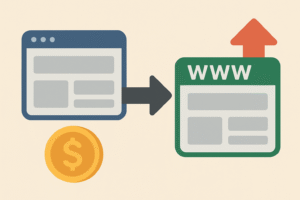 Professional migration services typically include tasks such as data transfer, server setup, DNS configuration, email migration, testing, and SEO optimization. Each of these elements contributes to the overall cost but also ensures that the migration is executed flawlessly. Attempting to cut costs by performing migration without adequate expertise can result in errors that are far more expensive to fix later. Downtime, loss of search engine rankings, and corrupted data often outweigh initial savings, making professional support a worthwhile investment.
Professional migration services typically include tasks such as data transfer, server setup, DNS configuration, email migration, testing, and SEO optimization. Each of these elements contributes to the overall cost but also ensures that the migration is executed flawlessly. Attempting to cut costs by performing migration without adequate expertise can result in errors that are far more expensive to fix later. Downtime, loss of search engine rankings, and corrupted data often outweigh initial savings, making professional support a worthwhile investment.
Businesses should also consider ongoing expenses post-migration. These may include upgraded hosting fees, security enhancements, and monitoring tools to maintain website performance and uptime. Although migration involves upfront costs, the long-term benefits—such as improved speed, reliability, security, and SEO performance—often result in higher revenue and stronger brand reputation. By evaluating both immediate and ongoing costs, companies can make informed decisions and approach Website and Domain Migration as a strategic investment in digital growth.
Future-Proofing Your Website After Migration
Completing Website and Domain Migration is not the end of the journey—it is the beginning of a stronger digital presence. Once the new environment is live, businesses must take proactive steps to future-proof their websites. This means preparing the site for growth, ensuring it remains secure, and staying ahead of technological advancements. A website that is not future-proof risks falling behind competitors and facing costly upgrades sooner than necessary.
One way to future-proof a website is through scalability. As businesses expand, their websites must handle larger traffic volumes, greater amounts of data, and more complex applications. Choosing a hosting solution that offers scalability, such as cloud-based platforms, ensures that resources can be adjusted easily without requiring another migration. Regular updates to content management systems, plugins, and themes also protect the site from vulnerabilities while ensuring compatibility with new technologies.
Another important consideration is monitoring emerging trends in website performance and security. Features such as mobile-first design, advanced caching solutions, and enhanced encryption protocols should be implemented early to stay ahead of industry standards. Businesses should also adopt monitoring tools that provide real-time insights into traffic, uptime, and security threats. By investing in these measures, organizations ensure that the results of Website and Domain Migration continue to pay dividends well into the future, maintaining stability, reliability, and growth.
Professional Support for Website and Domain Migration
While some businesses attempt Website and Domain Migration independently, many find that professional support is invaluable. Migration involves a wide range of technical tasks—server configuration, DNS updates, SEO optimization, and data security—that can overwhelm teams without specialized expertise. Professional support ensures that every aspect of the process is handled with precision, reducing risks and guaranteeing a seamless transition.
Experts bring both experience and tools to the table, allowing them to anticipate potential issues and resolve them quickly. For example, professional teams know how to handle DNS propagation delays, configure SSL certificates correctly, and implement proper redirects to preserve SEO. They also provide structured testing and monitoring, ensuring that the migrated site performs optimally from day one. With professional support, businesses gain not only technical expertise but also peace of mind knowing that their digital presence is secure and uninterrupted.
The cost of professional services is often outweighed by the long-term benefits they provide. Avoiding downtime, preventing data loss, and preserving search rankings translate directly into financial savings and business continuity. Moreover, expert support allows internal teams to focus on core operations instead of being bogged down by technical complexities. For companies serious about protecting their brand and ensuring a smooth transition, professional assistance is not a luxury but a necessity in the Website and Domain Migration process.
Conclusion: Strengthening Your Digital Future with Migration
Website and Domain Migration is more than a technical task; it is a strategic move that shapes the future of a business’s online presence. From planning and backups to SEO preservation and post-migration monitoring, every step plays a role in ensuring that the transition is smooth, secure, and beneficial. A successful migration enhances performance, protects data, improves scalability, and strengthens brand credibility—all while minimizing risks of downtime and SEO loss.
At FixHackedSite, we understand that migration is a critical milestone for businesses seeking growth and security. Many organizations underestimate its complexity, only to encounter broken links, lost rankings, or frustrated customers. With the right planning, professional support, and commitment to detail, migration becomes a powerful opportunity rather than a risk. Businesses that approach it strategically find themselves with a faster, more secure, and more future-ready digital foundation.
In today’s fast-paced digital landscape, standing still is not an option. Migration enables businesses to adapt, evolve, and thrive in competitive markets. By treating Website and Domain Migration as a long-term investment instead of a temporary fix, organizations position themselves for sustained success. Whether it is improving performance, securing sensitive data, or enhancing brand visibility, migration represents a step forward in building a stronger, more reliable digital future.
